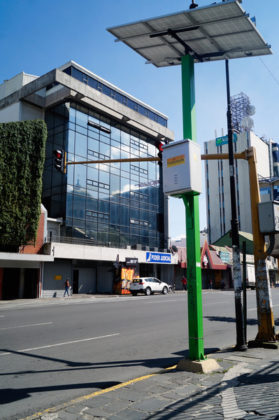
CRH
The 132 traffic light systems that operate in Alajuela, Heredia and Cartago will soon operate with solar energy. The Ministry of Public Works and Transportation (MOPT) announced that it is the fifth stage of a plan involving 132 intersections. There are some devices with solar panels already working in San José.
The $ 1.5 million (more than 867 million colones) are financed by the Road Safety Council (Cosevi). In total, the objective is that the 474 traffic light systems at the central points of the Greater Metropolitan Area (GAM) operate mostly with solar energy.
We already have 75% of the works for the placement of photovoltaic systems, which will allow the operation of traffic lights with clean energy, in this case, from the sun,”
said Diego Rugama, head of the traffic lights department of MOPT, through a press release.
Nearly 30 traffic lights are already installed for the placement of the panels and it is estimated that next November the 132 systems will be ready. These teams will make up 100% of the Traffic Control Center (CCT) for traffic lights.
The devices are installed by the company Sistema Empresarial RC SA, which was responsible for the execution of the previous stages.
The project aims to improve road safety. Electrical cuts or power outages have already been experienced in places where this type of device is available and work perfectly, so that the absence of electricity does not affect traffic. In addition to the improvement in road safety, the operation of these systems with clean energy represents an important saving in electricity consumption,”
said the official report.
How do these equipment work?
The equipment has the capacity to work without sunlight for up to 14 hours. In addition to the solar panel, batteries that store energy are placed. If for some reason this load is not enough, it automatically connects to the electrical system so that its operation is never interrupted.
If the solar panels are charged, they automatically disconnect from the network and Take the solar energy again.
As explained by the entity, the number of panels or batteries to be placed at each intersection depends on the design of sun hours in which Transit Engineering assesses, prior to each stage, two fundamental aspects: solar radiation at the point and obstacles that may arise.